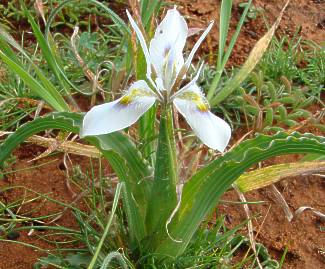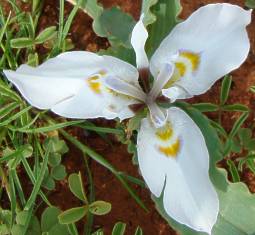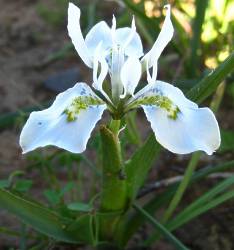Moraea ciliata
Moraea ciliata (L. f.) Ker Gawl
Family: Iridaceae
Common names: growweuintjie (Afr.)
Introduction
Moraea ciliata is a stemless geophyte (a deciduous perennial with underground renewal buds) with 3or 4 narrow and channelled leaves. The flowers are white, blue or yellow with yellow nectar guides and have a vanilla scent.

Description
Description
Moraea ciliata grows up to 20 cm high and has no branches. It has an underground stem with a single inflorescence. The flowers are enclosed in a single spathe instead of the usual two. Although seedlings have a fairly typical long channelled leaf, mature plants have short, broadly channelled and ciliate to pubescent leaves. The pedicels are contractile, and after blooming the ovary is withdrawn into the base of the spathe where the fruit develops.

The flowers are always strongly scented and have a sweet, rich, spicy fragrance. They are unusually variable in colour. Although blue is the most common, yellow to brown and white flowers also occur.
Conservation Status
Status
Moraea ciliata is widespread and is listed as Least Concern (LC) (Raimondo et al. in prep.).
Distribution and habitat
Distribution description
Moraea ciliata occurs over the entire winter-rainfall area, as well as neighbouring parts of the summer-rainfall region of southern Africa. The plants occur on clay or sandy slopes and flats and can withstand varied conditions, from high rainfall on the Cape Peninsula to less than 120 mm in parts of Namaqualand and the Karoo.
Derivation of name and historical aspects
History
The genus Moraea (Iridaceae) is a close relative of the genus Iris, and it is presumed that it evolved independently from Iris itself, which is restricted to the Northern Hemisphere. Thus, it is truly an African genus ranging from Nigeria and southern Ethiopia, into the African highlands down to the southern tip of Africa where winter rainfall is prevalent. It is in the winter-rainfall area where one finds the highest concentration of Moraea species. Philip Miller’s publication of the genus, with the spelling Morea, was published in 1758. In 1762 the Swedish botanist Carl Linnaeus in the second edition of his Species plantarum altered the spelling to Moraea, most probably because he wanted to commemorate his father-in-law and their family name Moraeus.
Ciliata means fringed with hairs and describes the fine and rather sparse hairs on the leaf margins. These fine hairs are quite often also found on the inflorescence spathes.
Ecology
Ecology
Not much is known about the pollination of Moraea. The flowers seem to be well adapted to bee- and especially small bee pollination. The vanilla-scented flowers, with their striking and brightly colourful patterns, have contrasting nectar guides which are an added attraction for possible pollinators. Beetles are also common visitors to Moraea flowers, but seldom, if ever, accomplish pollination.


Growing Moraea ciliata
Grow
Moraea ciliata is not cultivated widely, but at Kirstenbosch it responds favourably to being planted in a pot or rock garden, and with just a bit of attention will increase profusely, rewarding the gardener with lots of flowers. M. ciliata likes to be kept fairly dry during its dormant period (summer). Providing plants are given ample water during their flowering season they will grow well and produce many large flowers which create a lovely display in late winter. Moraea ciliata can either be grown from seed, or the underground stems can be split up. Seed may be sown in April at the start of the winter rains (southern hemisphere), and the underground stems can be split up in January or February when the plant is dormant.
Each flower lasts for only a day and starts to droop in the early evening. This means that flowers cannot be used for display or flower arrangements. The flowering season lasts approximately three weeks.
References
- Goldblatt, P. 1986. The Moraeas of southern Africa. Annals of Kirstenbosch Botanic Gardens 14.
- Goldblatt, P. & Manning, J.C. 2000. Iridaceae. InO.A. Leistner (ed.),Seed plants of southern Africa. Strelitzia 10: 623–638. National Botanical Institute, Pretoria.
- Duncan, D.G. 2000. Grow bulbs. Kirstenbosch Gardening Series. National Botanical Institute, Cape Town.
- http://www.mnhn.fr/museum/front/medias/publication/5293_a05n1a3.pdf
- Raimondo, D., Von Staden, L., Foden, W., Victor, J.E., Helme, N.A., Turner, R.C., Kamundi, D.A. & Manyama, P.A. (eds). in prep. Red List of South African plants. Strelitzia.
Credits
Colleen Rust
Hantam National Botanical Garden
February 2010
Plant Attributes:
Plant Type: Bulb
SA Distribution: Eastern Cape, Northern Cape, Western Cape
Soil type: Sandy, Clay
Flowering season: Winter
PH: Acid, Alkaline, Neutral
Flower colour: Blue, Brown, White, Yellow
Aspect: Full Sun
Gardening skill: Challenging
Special Features:
Horticultural zones









Rate this article
Article well written and informative
Rate this plant
Is this an interesting plant?
Login to add your Comment
Back to topNot registered yet? Click here to register.